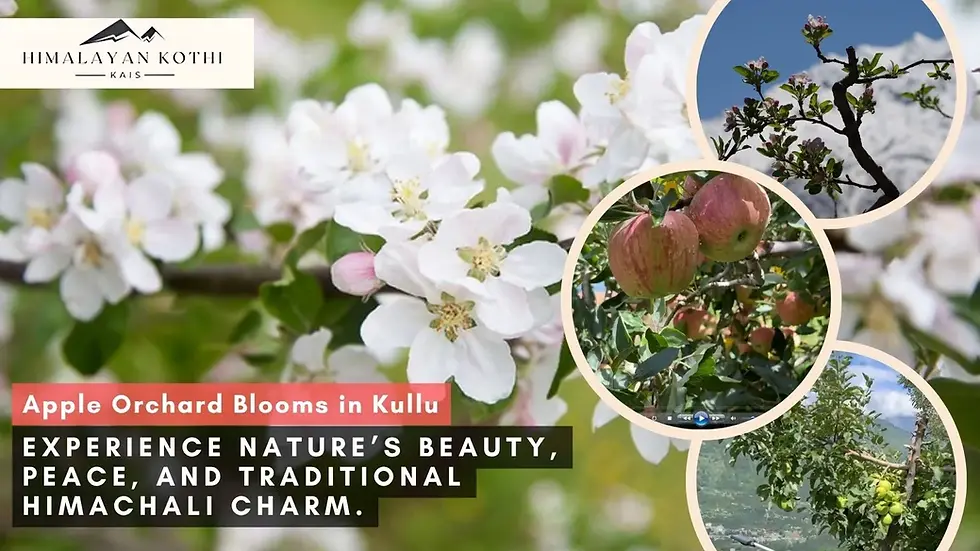Kath‑Kuni: Himachal’s Traditional Carbon‑Neutral Architecture
- Himalayan Kothi
- Jun 23
- 3 min read

Nested in the grand hills of Himachal Pradesh, particularly in Kullu, is an architectural wonder that combines tradition, sustainability, and strength—Kath‑Kuni. The original construction method, which local people designed centuries ago, is a beaming epitome of how local knowledge can design climate-conscious and carbon-neutral buildings in Kullu, Himachal Pradesh.
What is Kath‑Kuni Architecture?
The origin of the name Kath‑Kuni is two words: Kath, for wood, and Kuni, for corners or angles. It is a particular type of construction with alternating layers of wood and stone, connected at corners by means other than cement or mortar. The materials are locally available—deodar wood and fieldstones for instance—so Kath‑Kuni houses are inherently sustainable and ecological in nature.
Built for the Mountains, Built for the Ages
Himachal is a seismically active region, and earthquakes are common. The ingenuity of the Kath‑Kuni method is that it will bend with the earth. The pliable interlocking wood and thick stones distribute the seismic shocks, and with stability and flexibility, the houses have a very low vulnerability to earthquakes.
The plan is also climate-adapted for the mountain environment. The dense walls offer insulation against the cold winter air, and slender windows placed in strategic positions retain the heat within. In the summer, the buildings remain cool through cross-ventilation and sunshade verandas. Artificial heating and cooling devices are not required, further adding to their carbon-neutral credentials.

Zero Waste, Zero Carbon
What renders Kath‑Kuni a sustainability champion is its cyclical construction philosophy. All components of the house, be it wood beams or stone walls and even mud plaster, are biodegradable and recyclable. If a building is taken apart, the materials can be recycled and reused in another house. Minimal to no construction waste, and zero reliance on high-emission materials such as cement and steel.
This inevitably translates into carbon-neutral buildings in Kullu, Himachal Pradesh, where developers make use of resources available in their immediate environment. The employment of rot-resistant and durable wood of deodar ensures that these houses can last for over a hundred years—a testament that longevity and minimal carbon print can go together.
A Layer of Culture and Craftsmanship
It's not merely utilitarian in nature—it reflects the culture and skill of Himachal. Intricately cut wood panels, decorative balconies, and sloping slate roofs define Kath‑Kuni. The technique is employed in temples, forts, and traditional homes as well, combining structural integrity with looks.
These houses are also functional in design. In the past, the ground floor was utilized for cattle, which served to insulate the living space above. Storage rooms and granaries took up the middle floors, with the family residing on the upper floors. This zoning provided thermal comfort and maximized use of space.
A Dying Art in Need of Revival
Sadly, urbanization and contemporary construction practices are marginalizing Kath‑Kuni architecture. Traditional houses are being replaced by concrete structures, usually disregarding the region's specific climatic and seismic requirements. Additionally, the skilled artisans capable of building Kath‑Kuni houses are decreasing in numbers.
But hope exists. Of late, there has been a revival effort spearheaded by architects, conservationists, and local communities to propagate these carbon-neutral buildings. Environment-friendly tourists are now flocking to Kath‑Kuni homestays, and new buildings are being constructed applying modified versions of the technique that blend traditional with modern needs.
Why Kath‑Kuni Matters Today
In an age of climate change, increasing construction emissions, and increasing demand for sustainable living, Kath‑Kuni presents an age-old solution. It demonstrates that building green is not always a matter of new technology—it can be as simple as going back in time and trying what the past has learned.
By selecting carbon-neutral buildings in Kullu, Himachal Pradesh, based on the Kath‑Kuni approach, we pay respect to local heritage, engage in community-based craftsmanship, and contribute positively toward a greener future.
Kath‑Kuni is more than an architectural technique; it's a philosophy of harmony—between people, nature, and built landscape.
Find Himalayan Kothi -Your Kathkuni Retreat
You are welcome to visit Himalayan Kothi, a place which will offer you boutique comfort in a traditional Kathkuni house set amid apple orchards in the Kullu valley. Our boutique hotels in Himachal Pradesh is famous with respect to green buildings in Kullu, and majestic views of mountains.
Book your vacation and get in touch with nature now!
Frequently Asked Questions
1. Which type of rooms do we have?
There are Deluxe rooms, Attic, and Super Deluxe rooms where the elements of tradition are blended by modern conveniences.
2. What is your find?
We are located in the Manjdhari village that lies at a very small distance away compared to the central region of Kullu, which can be easily commuted through a personal vehicle.
3. Do we have meals?
Yes! Our specialties are home-style Himachali and continental breakfast and well-prepared meals.
4. Are we pet friendly?
We love animals, and pets will be allowed in our premises.





Comments